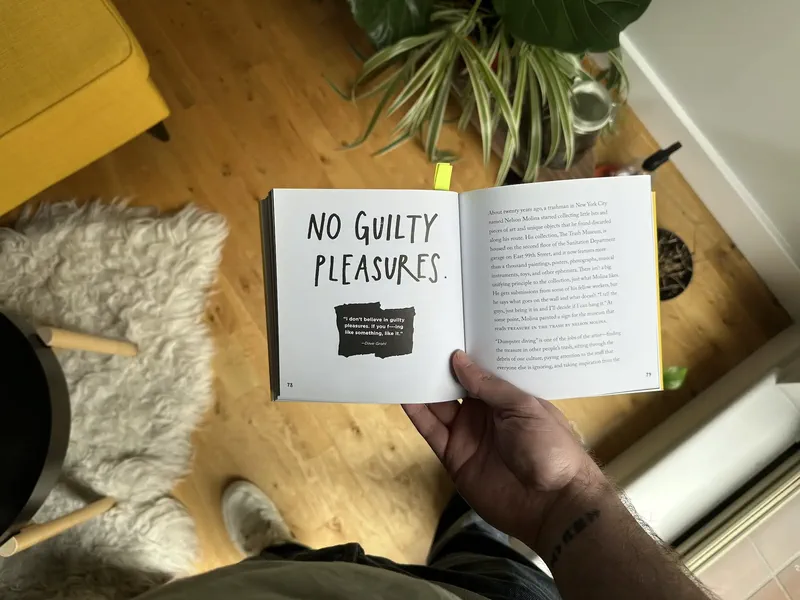Today, I want to write about some of the books that unlocked me, as an artist and creative person. I want to share with you four books that I would recommend to stuck creatives1.
If you identify with any of these creative demons, I think those books will help you:
- You are stuck with the blank page syndrome
- Your inner critic tells you that you are not good enough
- You have lost the energy to even start. Creating feels draining.
- You feel like you never have the time
- You never finish anything. Projects pile up, half-done.
- You are scared of putting your imperfect work out there
- You feel like you are not original - everything has already been done
Don’t worry if you don’t use paintbrushes or record music. If your work involves any kind of creative problem-solving (any tech folks in the room?), I really believe you’ll find value here.
Let’s dive in!
Steal Like an Artist - Austin Kleon
“If I’d waited to know who I was or what I was about before I started ‘being creative’, well, I’d still be sitting around trying to figure myself out instead of making things. In my experience, it’s in the act of making things and doing our work that we figure out who we are.
You’re ready. Start making stuff.”
- Austin Kleon (Steal Like an Artist)
This is one of my favourite creativity books, ever. It was a revelation, and changed my life.
I read it at least once a year, and I pick it up anytime I’m stuck.
Some of the things that this book taught me:
- Don’t wait to know who you are to get started
- Nobody is born with a style or a voice - we learn by copying
- Write the book you want to read
- Computers are good for editing, but not so good for generating ideas - there is a backspace key!
- Go analog, it will make you more creative. Play. Use your hands.
- Embrace boredom
- Use constraints. The idea that you can do anything can be paralysing. You can get over the creative block by putting constraints on yourself.
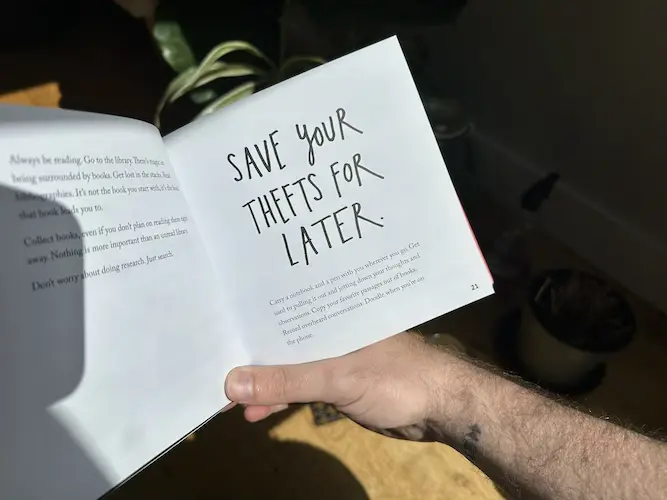
Steal from others. Copy.
Really, it’s okay. That’s how we learn, that’s how we get inspiration. No art is born in a vacuum.
Steal like an artist, and acknowledge it - don’t plagiarise! Credit people. Transform, make things your own. Nothing is original.
This is the first book that made me feel seen. It normalised all the things I’ve been struggling with, the blockers in my head. You know, the voices that tell you that you’re not good enough, that you’re not original, that you shouldn’t bother because someone has already done it? If you’re reading this, I imagine you know what I am talking about :)
“Steal Like an Artist” helped me create my weekly YouTube series Metro Boulot Homestudio, and it helped me go through the recording of my first EP.
If you’re stuck, definitely get his book. It’s a super easy read, has some powerful messages and it will help with some of the guilt that comes with being an artist.
Show Your Work! - Austin Kleon
“Overnight success is a myth. Dig into almost every overnight success story and you’ll find about a decade’s worth of hard work and perseverance. Building a substantial body of work takes a long time - a lifetime, really - but thankfully, you don’t need that time all in one chunk.
So forget about decades, forget about years, and forget about months. Focus on days.”
- Austin Kleon (Show Your Work!)
I see this one as the companion book to “Steal Like an Artist”.
More than just tips to make yourself more visible, it explores some of the things that tend to lead to overthinking, as an artist.
It brought me clarity and helped me simplify how I think about my art, and trim shame and guilt from my process. It gave me energy to get back to my studio and hack away. It made me feel seen, understood: it’s natural to be scared of sharing work, and struggling with finishing is normal. It actually helped me redefine what finished means to me.
Show Your Work! helped me explore my personal YouTube channel, with projects like A Creative Experiment, and vlogs about the creative process. It was also a massive help for Metro Boulot Homestudio and, well, this blog!
This is another book that I read at least once a year.
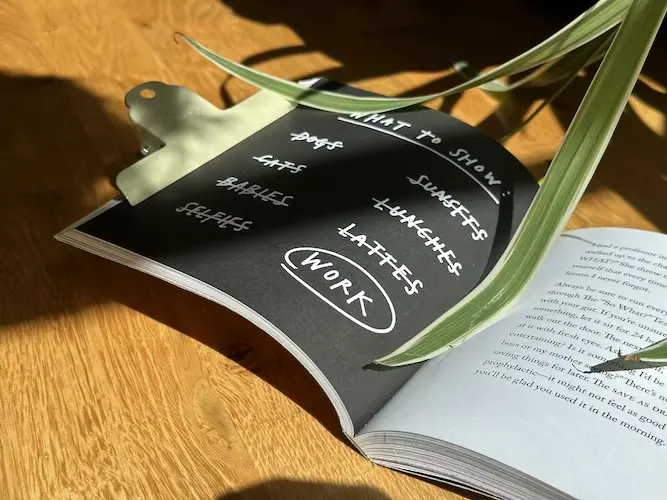
Some of the things this book taught me:
- The lone genius myth is just a myth (and is quite harmful)
- You can’t find your voice if you don’t use it
- Think process, not product: there’s painting, the noun, and painting, the verb
- Become a documentarian of what you do. Send a daily dispatch.
- Overnight success is a myth
- Forget about decades, years, months. Focus on days. They add up.
- There’s always something to share about what you do: influences, inspirations, methods, work in progress, finished product, behind the scenes, learnings, b-sides, how people use your work…
- Stock vs Flow2: the little things, notes, blog posts, ideas, vlogs… they add up and can become the base material for your stock: a book, an album, a documentary, etc.
Whenever I read this book, I feel better afterwards. I feel energised.
Deep Work - Cal Newport
“The productivity equation is a non-linear one, in other words. This accounts for why I am a bad correspondent and why I very rarely accept speaking engagements.
If I organise my life in such a way that I get lots of long, consecutive, uninterrupted time-chunks, I can write novels. But as those chunks get separated and fragmented, my productivity as a novelist drops spectacularly.”- Neal Stephenson (science fiction writer)
When I started reading this book, I knew it was going to help me with work. However, I had no idea it was going to unlock me in my creative life too. Another book that changed my life!
In this book, I learned that willpower was finite, like a battery or a muscle. You can run out, and you have to rest to recharge it.
It taught me how to best leverage the amount of willpower I have for a day, and what to do if I run out.
It taught me the difference between deep work (creative, ambiguous, lots of unknowns and decision making) and shallow work (procedured, not much hard decision making, not very involved, can dip in and out), and how to best use them to take advantage of that willpower battery.
It helped me match my energy levels and time slots with the right type of task.
It helped me feel less guilty, and made me feel seen. So many other people struggle with making decisions, getting distracted and losing steam (it’s not just me!), and Cal Newport gives actionable, down to earth, relatable tips based on real people’s process.
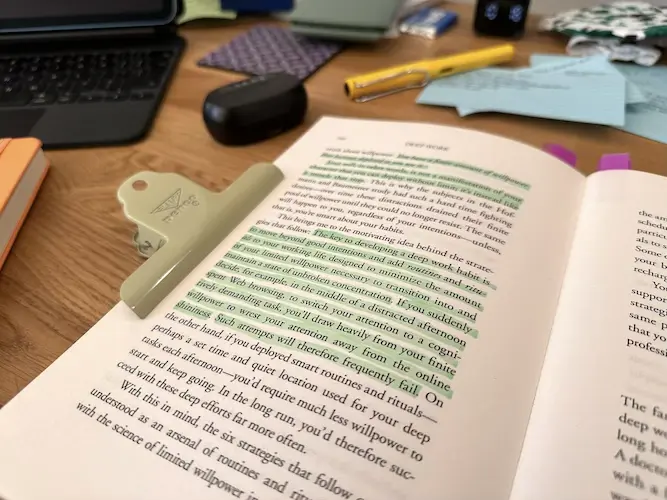
Some of the things this book taught me:
- Switching from task A to task B leaves some attention residue
- Working on a single hard task for a long time without switching allows you to go deeper, and minimises attention residue - it’s more effective
- Checking your email or your phone every few minutes is really harmful to your ability to focus and go deep on a challenging task
- We are what we pay attention to: Focus your attention on your worries and you will be unhappy. Focus your attention on this musical that you are attending with your friend in a few days, and you’ll be happier.
- Good intentions are not enough: you have to add routines and rituals to your life, to reduce the amount of decision making energy you take from your willpower battery
- Scheduling deep work + making it a routine = more deep work hours done at the end of the year = more stuff done (writing novels, recording videos or music albums, etc.)
- Ignore inspiration: show up regularly even if you are not inspired. Pick up the pen and write.
- Embrace boredom (see this blog post I wrote last year)
- Quit social media
One of the best skills I developed after reading this book was the ability to figure out if a task is deep or shallow, and why. And that sometimes you can make a task that requires deep focus less hard by breaking it down and removing shallow bits from it if it’s possible.
What a game changer!
The Obstacle Is The Way - Ryan Holiday
“The first iPhone was revolutionary, but it still shipped without a copy-and-paste feature, or a handful of other features Apple would have liked to have included.
Steve Jobs, the supposed perfectionist, knew that at some point, you have to compromise. What mattered was that you got it done and it worked.”- Ryan Holiday (The Obstacle Is The Way)
This punchy little book is a mindset shift book.
It delivers brutal common sense, based on Stoic philosophy, in a kind way. It can sometimes be a bit blunt, but it tells good stories that stick with you and are relatable.
About two thousand years ago, Marcus Aurelius, Emperor of Rome, kept a journal. In it, he wrote his thoughts, his worries, his struggles, his learnings about himself. This journal is known today as the book “Meditations”. What he wrote back then isn’t that different from what gets our minds stuck today, from what we would journal about. And he wrote that 2000 years ago, in a very different society, while being one of the most powerful people on the planet!
There is something humbling about that.
This book introduced me to Stoicism, and helped me see that I am not alone, that I am not special (sorry mum!). Every day, others go through obstacles too, others fight with their internal monologue too, and they might even have been the emperor of Rome!
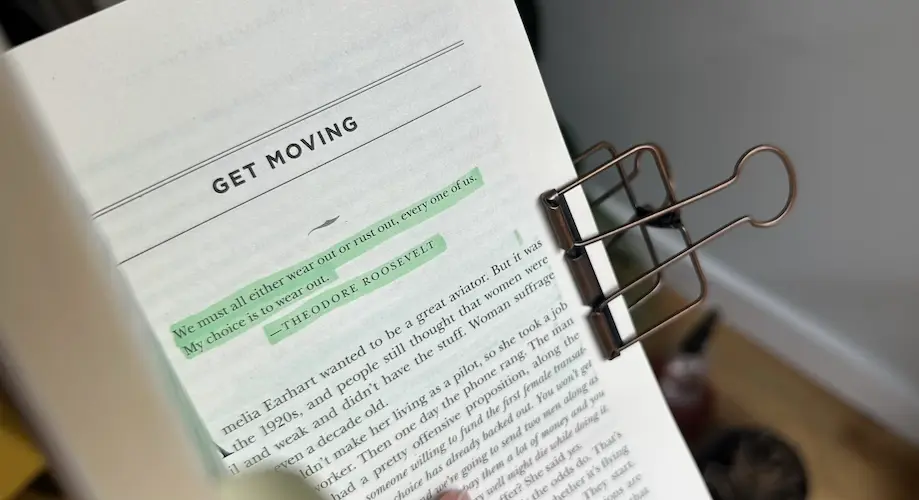
Some of the things this book taught me:
- Perception is something you can choose, and adapt
- Two categories in life: externals you cannot control, and choices you make about them
- If the emperor of Rome was journaling, then I can do it to
- When in a spiral: look at the facts, check against your perception, do this in writing, on paper
- Think progress, not perfection
- The Process: decompose hard and complex things into manageable pieces. Finish the smallest task in front of you, then move on to the next one
- Genius often really is just persistence in disguise
- We often know what the problems are. But we fear taking action is too risky. It matters what you do with what happens and what you have been given
- Helping others reduces our fears and anxieties. Random acts of kindness and conversations with strangers makes us feel better
- If I can’t solve it for myself, can I at least make it better for others?
- You learn and make progress by iterating, by trying and failing. You have to act now.
This is the kind of book that helps you with life.
I found myself with much less guilt after reading “The Obstacle is The Way”, and equipped with more tools to identify a way forward through obstacles.
Conclusion
Whenever you’re spiraling because of one of your creative demons, remember this: you are not alone!
That’s what these books showed me: validation, and a way forward. They helped me shake off some of the guilt that comes with the creative process. They taught me to act now, they encouraged me to be bored, and they reminded me that it’s okay to learn through iteration.
If you are a stuck creative, go and read one of those books. Take some notes.
And then, go make some stuff!
-
This post is not a replacement for reading the books. I am not trying to capture the message so that you don’t have to read them. Go read the books! ↩︎
-
See this blog post by Austin Kleon: A few notes on daily blogging ↩︎
